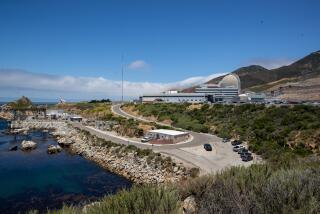Power Turbine Project Saves Tech Center From Closing : Engineering: The thermodynamics testing program will keep the facility working and save 200 jobs.
- Share via
The Department of Energy announced Thursday that it will keep open its Energy Technology Engineering Center near Simi Valley for research in a promising new technology for electrical power generation, known as the Kalina Cycle.
The center had been scheduled to be closed in September, with a loss of 200 high-tech jobs. It is operated by the Rocketdyne division of Rockwell International, which for decades tested components for nuclear power plants at the site.
“The issue in my mind was that we cannot lose this resource,” Energy Secretary Hazel O’Leary said Thursday at a news conference in Los Angeles.
The center, part of DOE’s Santa Susana Field Laboratory, is now assured of support through 1995, and will get a budget hike of $11.6 million, most of it to test the new technology, a prototype of which is already in place.
Community groups and proponents of an advanced transportation industry in Southern California have been lobbying hard to keep the site open. In December, DOE successfully sought out industrial partners to help support the center’s continued operation.
“We’re happy to hear this announcement, because there was concern that time was running out,” said John Slifko, special assistant for technology policy to Rep. Howard L. Berman (D-Panorama City). “We still think that a focus on transportation technologies is a premiere use of the site, and we will be working to get DOE’s additional support.”
But so far plans focus on development of the new electricity-generation process, Robert LeChevalier, DOE site manager, said Thursday.
“This is a really significant event,” LeChevalier said. “It’s the first new thermodynamic cycle that’s been invented since 1895.”
The new concept was devised by Alexander Kalina, an engineer from the former Soviet Union now living in Northern California. Potentially it could use almost any heat source--fueled by natural gas, coal or geothermal or solar energy--to produce electricity 20% more efficiently than current turbine technology.
An improvement of this magnitude could mean billions of dollars in energy savings in this country and internationally. The the technology center has the world’s sole operating model of the device.
“We’ve demonstrated the principles of the cycle,” LeChevalier said, “and a number of large utility suppliers are very interested . . . one is General Electric.”
The center also has projects in renewable technologies, energy conservation and earthquake-effects testing. Researchers there can test the effects of seismic events on the parts used to buffer buildings against earthquake, or utility structures such as pipe systems in power plants.
More to Read
Inside the business of entertainment
The Wide Shot brings you news, analysis and insights on everything from streaming wars to production — and what it all means for the future.
You may occasionally receive promotional content from the Los Angeles Times.










